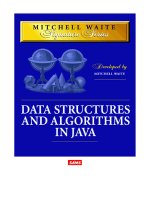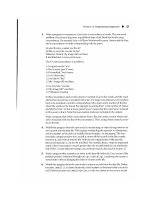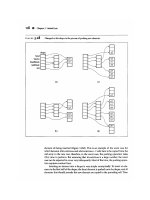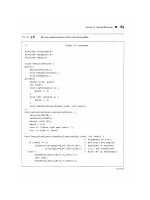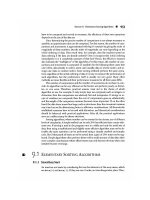data structures and algorithms in java fourth edition
Bạn đang xem bản rút gọn của tài liệu. Xem và tải ngay bản đầy đủ của tài liệu tại đây (14.41 MB, 924 trang )
Data Structures and Algorithms in Java
Michael T. Goodrich
Department of Computer Science University of California, Irvine
1
Roberto Tamassia
Department of Computer Science Brown University
0-471-73884-0
Fourth Edition
John Wiley & Sons, Inc.
ASSOCIATE PUBLISHER Dan Sayre
MARKETING DIRECTOR Frank Lyman
EDITORIAL ASSISTANT Bridget Morrisey
SENIOR PRODUCTION EDITOR Ken Santor
COVER DESIGNER Hope Miller
COVER PHOTO RESEARCHER Lisa Gee
COVER PHOTO Ralph A.
Clevenger/Corbis
This book was set in by the authors and printed and bound by R.R. Donnelley
- Crawfordsville. The cover was printed by Phoenix Color, Inc.
Front Matter
To Karen, Paul, Anna, and Jack
-Michael T. Goodrich
2
To Isabel
-Roberto Tamassia
Preface to the Fourth Edition
This fourth edition is designed to provide an introduction to data structures and
algorithms, including their design, analysis, and implementation. In terms of curricula
based on the IEEE/ACM 2001 Computing Curriculum, this book is appropriate for
use in the courses CS102 (I/O/B versions), CS103 (I/O/B versions), CS111 (A
version), and CS112 (A/I/O/F/H versions). We discuss its use for such courses in
more detail later in this preface.
The major changes, with respect to the third edition, are the following:
• Added new chapter on arrays, linked lists, and recursion.
• Added new chapter on memory management.
• Full integration with Java 5.0.
• Better integration with the Java Collections Framework.
• Better coverage of iterators.
• Increased coverage of array lists, including the replacement of uses of the class
java.util.Vector with java.util.ArrayList.
• Update of all Java APIs to use generic types.
• Simplified list, binary tree, and priority queue ADTs.
• Further streamlining of mathematics to the seven most used functions.
• Expanded and revised exercises, bringing the total number of reinforcement,
creativity, and project exercises to 670. Added exercises include new projects on
maintaining a game's high-score list, evaluating postfix and infix expressions,
minimax game-tree evaluation, processing stock buy and sell orders, scheduling
CPU jobs, n-body simulation, computing DNA-strand edit distance, and creating
and solving mazes.
This book is related to the following books:
• M.T. Goodrich, R. Tamassia, and D.M. Mount, Data Structures and Algorithms
in C++, John Wiley & Sons, Inc., 2004. This book has a similar overall structure to
the present book, but uses C++ as the underlying language (with some modest, but
necessary pedagogical differences required by this approach). Thus, it could make
3
for a handy companion book in a curriculum that allows for either a Java or C++
track in the introductory courses.
• M.T. Goodrich and R. Tamassia, Algorithm Design: Foundations, Analysis, and
Internet Examples, John Wiley & Sons, Inc., 2002. This is a textbook for a more
advanced algorithms and data structures course, such as CS210 (T/W/C/S versions)
in the IEEE/ACM 2001 curriculum.
Use as a Textbook
The design and analysis of efficient data structures has long been recognized as a
vital subject in computing, for the study of data structures is part of the core of
every collegiate computer science and computer engineering major program we are
familiar with. Typically, the introductory courses are presented as a two- or three-
course sequence. Elementary data structures are often briefly introduced in the first
programming or introduction to computer science course and this is followed by a
more in-depth introduction to data structures in the following course(s).
Furthermore, this course sequence is typically followed at a later point in the
curriculum by a more in-depth study of data structures and algorithms. We feel that
the central role of data structure design and analysis in the curriculum is fully
justified, given the importance of efficient data structures in most software systems,
including the Web, operating systems, databases, compilers, and scientific
simulation systems.
With the emergence of the object-oriented paradigm as the framework of choice for
building robust and reusable software, we have tried to take a consistent
objectoriented viewpoint throughout this text. One of the main ideas of the object-
oriented approach is that data should be presented as being encapsulated with the
methods that access and modify them. That is, rather than simply viewing data as a
collection of bytes and addresses, we think of data as instances of an abstract data
type (ADT) that include a repertory of methods for performing operations on the
data. Likewise, object-oriented solutions are often organized utilizing common
design patterns, which facilitate software reuse and robustness. Thus, we present
each data structure using ADTs and their respective implementations and we
introduce important design patterns as means to organize those implementations
into classes, methods, and objects.
For each ADT presented in this book, we provide an associated Java interface.
Also, concrete data structures realizing the ADTs are provided as Java classes
implementing the interfaces above. We also give Java implementations of
fundamental algorithms (such as sorting and graph traversals) and of sample
applications of data structures (such as HTML tag matching and a photo album).
Due to space limitations, we sometimes show only code fragments in the book and
make additional source code available on the companion Web site,
.
4
The Java code implementing fundamental data structures in this book is organized
in a single Java package, net.datastructures. This package forms a coherent library
of data structures and algorithms in Java specifically designed for educational
purposes in a way that is complementary with the Java Collections Framework.
Web Added-Value Education
This book is accompanied by an extensive Web site:
.
Students are encouraged to use this site along with the book, to help with exercises
and increase understanding of the subject. Instructors are likewise welcome to use
the site to help plan, organize, and present their course materials.
For the Student
for all readers, and specifically for students, we include:
• All the Java source code presented in this book.
• The student version of the net.datastructures package.
• Slide handouts (four-per-page) in PDF format.
• A database of hints to all exercises, indexed by problem number.
• Java animations and interactive applets for data structures and algorithms.
• Hyperlinks to other data structures and algorithms resources.
We feel that the Java animations and interactive applets should be of particular
interest, since they allow readers to interactively "play" with different data
structures, which leads to better understanding of the different ADTs. In addition,
the hints should be of considerable use to anyone needing a little help getting
started on certain exercises.
For the Instructor
For instructors using this book, we include the following additional teaching aids:
• Solutions to over two hundred of the book's exercises.
• A keyword-searchable database of additional exercises.
• The complete net.datastructures package.
5
• Additional Java source code.
• Slides in Powerpoint and PDF (one-per-page) format.
• Self-contained special-topic supplements, including discussions on convex
hulls, range trees, and orthogonal segment intersection.
The slides are fully editable, so as to allow an instructor using this book full
freedom in customizing his or her presentations.
A Resource for Teaching Data Structures and Algorithms
This book contains many Java-code and pseudo-code fragments, and over 670
exercises, which are divided into roughly 40% reinforcement exercises, 40%
creativity exercises, and 20% programming projects.
This book can be used for courses CS102 (I/O/B versions), CS103 (I/O/B versions),
CS111 (A version), and/or CS112 (A/I/O/F/H versions) in the IEEE/ACM 2001
Computing Curriculum, with instructional units as outlined in Table 0.1.
Table 0.1: Material for Units in the IEEE/ACM 2001
Computing Curriculum.
Instructional Unit
Relevant Material
PL1. Overview of Programming Languages
Chapters 1 & 2
PL2. Virtual Machines
Sections 14.1.1
, 14.1.2, & 14.1.3
PL3. Introduction to Language Translation
Section 1.9
PL4. Declarations and Types
Sections 1.1, 2.4, & 2.5
PL5. Abstraction Mechanisms
Sections 2.4
, 5.1, 5.2, 5.3, 6.1.1, 6.2, 6.4, 6.3, 7.1, 7.3.1, 8.1, 9.1, 9.3, 11.6,
& 13.1
6
PL6. Object-Oriented Programming
Chapters 1 & 2 and Sections 6.2.2, 6.3, 7.3.7, 8.1.2, & 13.3.1
PF1. Fundamental Programming Constructs
Chapters 1
& 2
PF2. Algorithms and Problem-Solving
Sections 1.9
& 4.2
PF3. Fundamental Data Structures
Sections 3.1, 5.1-3.2, 5.3, , 6.1-6.4, 7.1, 7.3, 8.1, 8.3, 9.1-9.4, 10.1, & 13.1
PF4. Recursion
Section 3.5
SE1. Software Design
Chapter 2 and Sections 6.2.2, 6.3, 7.3.7, 8.1.2, & 13.3.1
SE2. Using APIs
Sections 2.4, 5.1, 5.2, 5.3, 6.1.1, 6.2, 6.4, 6.3, 7.1, 7.3.1, 8.1, 9.1, 9.3, 11.6,
& 13.1
AL1. Basic Algorithmic Analysis
Chapter 4
AL2. Algorithmic Strategies
Sections 11.1.1
, 11.7.1, 12.2.1, 12.4.2, & 12.5.2
AL3. Fundamental Computing Algorithms
Sections 8.1.4, 8.2.3, 8.3.5, 9.2, & 9.3.3, and Chapters 11, 12, & 13
DS1. Functions, Relations, and Sets
Sections 4.1
, 8.1, & 11.6
DS3. Proof Techniques
Sections 4.3, 6.1.4, 7.3.3, 8.3, 10.2, 10.3, 10.4, 10.5, 11.2.1, 11.3, 11.6.2,
13.1
, 13.3.1, 13.4, & 13.5
7
DS4. Basics of Counting
Sections 2.2.3 & 11.1.5
DS5. Graphs and Trees
Chapters 7
, 8, 10, & 13
DS6. Discrete Probability
Appendix A
and Sections 9.2.2, 9.4.2, 11.2.1, & 11.7
Chapter Listing
The chapters for this course are organized to provide a pedagogical path that starts
with the basics of Java programming and object-oriented design, moves to concrete
structures like arrays and linked lists, adds foundational techniques like recursion and
algorithm analysis, and then presents the fundamental data structures and algorithms,
concluding with a discussion of memory management (that is, the architectural
underpinnings of data structures). Specifically, the chapters for this book are
organized as follows:
1. Java Programming Basics
2. Object-Oriented Design
3. Arrays, Linked Lists, and Recursion
4. Analysis Tools
5. Stacks and Queues
6. Lists and Iterators
7. Trees
8. Priority Queues
9. Maps and Dictionaries
10. Search Trees
11. Sorting, Sets, and Selection
12. Text Processing
13. Graphs
8
14. Memory
A. Useful Mathematical Facts
Prerequisites
We have written this book assuming that the reader comes to it with certain
knowledge.That is, we assume that the reader is at least vaguely familiar with a
high-level programming language, such as C, C++, or Java, and that he or she
understands the main constructs from such a high-level language, including:
• Variables and expressions.
• Methods (also known as functions or procedures).
• Decision structures (such as if-statements and switch-statements).
• Iteration structures (for-loops and while-loops).
For readers who are familiar with these concepts, but not with how they are
expressed in Java, we provide a primer on the Java language in Chapter 1. Still, this
book is primarily a data structures book, not a Java book; hence, it does not provide
a comprehensive treatment of Java. Nevertheless, we do not assume that the reader
is necessarily familiar with object-oriented design or with linked structures, such as
linked lists, for these topics are covered in the core chapters of this book.
In terms of mathematical background, we assume the reader is somewhat familiar
with topics from high-school mathematics. Even so, in Chapter 4
, we discuss the
seven most-important functions for algorithm analysis. In fact, sections that use
something other than one of these seven functions are considered optional, and are
indicated with a star (). We give a summary of other useful mathematical facts,
including elementary probability, in Appendix A.
About the Authors
Professors Goodrich and Tamassia are well-recognized researchers in algorithms
and data structures, having published many papers in this field, with applications to
Internet computing, information visualization, computer security, and geometric
computing. They have served as principal investigators in several joint projects
sponsored by the National Science Foundation, the Army Research Office, and the
9
Defense Advanced Research Projects Agency. They are also active in educational
technology research, with special emphasis on algorithm visualization systems.
Michael Goodrich received his Ph.D. in Computer Science from Purdue University
in 1987. He is currently a professor in the Department of Computer Science at
University of California, Irvine. Previously, he was a professor at Johns Hopkins
University. He is an editor for the International Journal of Computational
Geometry & Applications and Journal of Graph Algorithms and Applications.
Roberto Tamassia received his Ph.D. in Electrical and Computer Engineering from
the University of Illinois at Urbana-Champaign in 1988. He is currently a professor
in the Department of Computer Science at Brown University. He is editor-in-chief
for the Journal of Graph Algorithms and Applications and an editor for
Computational Geometry: Theory and Applications. He previously served on the
editorial board of IEEE Transactions on Computers.
In addition to their research accomplishments, the authors also have extensive
experience in the classroom. For example, Dr. Goodrich has taught data structures
and algorithms courses, including Data Structures as a freshman-sophomore level
course and Introduction to Algorithms as an upper level course. He has earned
several teaching awards in this capacity. His teaching style is to involve the students
in lively interactive classroom sessions that bring out the intuition and insights
behind data structuring and algorithmic techniques. Dr. Tamassia has taught Data
Structures and Algorithms as an introductory freshman-level course since 1988.
One thing that has set his teaching style apart is his effective use of interactive
hypermedia presentations integrated with the Web.
The instructional Web sites, datastructures.net and
algorithmdesign.net, supported by Drs. Goodrich and Tamassia, are used as
reference material by students, teachers, and professionals worldwide.
Acknowledgments
There are a number of individuals who have made contributions to this book.
We are grateful to all our research collaborators and teaching assistants, who
provided feedback on early drafts of chapters and have helped us in developing
exercises, programming assignments, and algorithm animation systems.In
particular, we would like to thank Jeff Achter, Vesselin Arnaudov, James Baker,
Ryan Baker,Benjamin Boer, Mike Boilen, Devin Borland, Lubomir Bourdev, Stina
Bridgeman, Bryan Cantrill, Yi-Jen Chiang, Robert Cohen, David Ellis, David
Emory, Jody Fanto, Ben Finkel, Ashim Garg, Natasha Gelfand, Mark Handy,
Michael Horn, Beno^it Hudson, Jovanna Ignatowicz, Seth Padowitz, James
Piechota, Dan Polivy, Seth Proctor, Susannah Raub, Haru Sakai, Andy Schwerin,
Michael Shapiro, MikeShim, Michael Shin, Galina Shubina, Christian Straub, Ye
10
Sun, Nikos Triandopoulos, Luca Vismara, Danfeng Yao, Jason Ye, and Eric
Zamore.
Lubomir Bourdev, Mike Demmer, Mark Handy, Michael Horn, and Scott Speigler
developed a basic Java tutorial, which ultimately led to Chapter 1
, Java
Programming.
Special thanks go to Eric Zamore, who contributed to the development of the Java
code examples in this book and to the initial design, implementation, and testing of
the net.datastructures library of data structures and algorithms in Java. We are also
grateful to Vesselin Arnaudov and ike Shim for testing the current version of
net.datastructures
Many students and instructors have used the two previous editions of this book and
their experiences and responses have helped shape this fourth edition.
There have been a number of friends and colleagues whose comments have lead to
improvements in the text. We are particularly thankful to Karen Goodrich, Art
Moorshead, David Mount, Scott Smith, and Ioannis Tollis for their insightful
comments. In addition, contributions by David Mount to Section 3.5 and to several
figures are gratefully acknowledged.
We are also truly indebted to the outside reviewers and readers for their copious
comments, emails, and constructive criticism, which were extremely useful in
writing the fourth edition. We specifically thank the following reviewers for their
comments and suggestions: Divy Agarwal, University of California, Santa Barbara;
Terry Andres, University of Manitoba; Bobby Blumofe, University of Texas,
Austin; Michael Clancy, University of California, Berkeley; Larry Davis,
University of Maryland; Scott Drysdale, Dartmouth College; Arup Guha,
University of Central Florida; Chris Ingram, University of Waterloo; Stan Kwasny,
Washington University; Calvin Lin, University of Texas at Austin; John Mark
Mercer, McGill University; Laurent Michel, University of Connecticut; Leonard
Myers, California Polytechnic State University, San Luis Obispo; David Naumann,
Stevens Institute of Technology; Robert Pastel, Michigan Technological University;
Bina Ramamurthy, SUNY Buffalo; Ken Slonneger, University of Iowa; C.V.
Ravishankar, University of Michigan; Val Tannen, University of Pennsylvania;
Paul Van Arragon, Messiah College; and Christopher Wilson, University of
Oregon.
The team at Wiley has been great. Many thanks go to Lilian Brady, Paul Crockett,
Simon Durkin, Lisa Gee, Frank Lyman, Madelyn Lesure, Hope Miller, Bridget
Morrisey, Ken Santor, Dan Sayre, Bruce Spatz, Dawn Stanley, Jeri Warner, and
Bill Zobrist.
The computing systems and excellent technical support staff in the departments of
computer science at Brown University and University of California, Irvine gave us
reliable working environments. This manuscript was prepared primarily with the
11
typesetting package for the text and Adobe FrameMaker® and Microsoft
Visio® for the figures.
Finally, we would like to warmly thank Isabel Cruz, Karen Goodrich, Giuseppe Di
Battista, Franco Preparata, Ioannis Tollis, and our parents for providing advice,
encouragement, and support at various stages of the preparation of this book. We
also thank them for reminding us that there are things in life beyond writing books.
Michael T. Goodrich
Roberto Tamassia
Chapter 1 Java Programming Basics
Contents
1.1
12
Getting Started: Classes, Types, and Objects
2
1.1.1
Base
Types
5
1.1.2
Objects
7
1.1.3
Enum
Types
.
14
1.2
Methods
15
1.3
Expressions
20
1.3.1
Literals
20
1.3.2
Operators
21
1.3.3
13
Casting and Autoboxing/Unboxing in
Expressions
25
1.4
Control Flow
27
1.4.1
The If and Switch
Statements
27
1.4.2
Loops
29
1.4.3
Explicit Control-Flow
Statements
32
1.5
Arrays
34
1.5.1
Declaring
Arrays
36
1.5.2
Arrays are
Objects
37
1.6
Simple Input and Output
14
39
1.7
An Example Program
42
1.8
Nested Classes and Packages
45
1.9
Writing a Java Program
47
1.9.1
Design
47
1.9.2
Pseudo-
Code
48
1.9.3
Coding
49
1.9.4
Testing and
Debugging
53
1.10
Exercises
55
java.datastructures.net
15
1.1 Getting Started: Classes, Types, and Objects
Building data structures and algorithms requires that we communicate detailed
instructions to a computer, and an excellent way to perform such communication is
using a high-level computer language, such as Java. In this chapter, we give a brief
overview of the Java programming language, assuming the reader is somewhat
familiar with an existing high-level language. This book does not provide a complete
description of the Java language, however. There are major aspects of the language
that are not directly relevant to data structure design, which are not included here,
such as threads and sockets. For the reader interested in learning more about Java,
please see the notes at the end of this chapter. We begin with a program that prints
"Hello Universe!" on the screen, which is shown in a dissected form in Figure 1.1.
Figure 1.1: A "Hello Universe!" program.
16
The main "actors" in a Java program are objects. Objects store data and provide
methods for accessing and modifying this data. Every object is an instance of a class,
which defines the type of the object, as well as the kinds of operations that it
performs. The critical members of a class in Java are the following (classes can also
contain inner class definitions, but let us defer discussing this concept for now):
• Data of Java objects are stored in instance variables (also called fields).
Therefore, if an object from some class is to store data, its class must specify the
instance variables for such objects. Instance variables can either come from base
types (such as integers, floating-point numbers, or Booleans) or they can refer to
objects of other classes.
• The operations that can act on data, expressing the "messages" objects respond to,
are called methods, and these consist of constructors, procedures, and functions.
They define the behavior of objects from that class.
How Classes Are Declared
In short, an object is a specific combination of data and the methods that can
process and communicate that data. Classes define the types for objects; hence,
objects are sometimes referred to as instances of their defining class, because they
take on the name of that class as their type.
An example definition of a Java class is shown in Code Fragment 1.1
.
Code Fragment 1.1: A Counter class for a simple
counter, which can be accessed, incremented, and
decremented.
17
In this example, notice that the class definition is delimited by braces, that is, it
begins with a "{" and ends with a "} ". In Java, any set of statements between the
braces "{" and "}" define a program block.
As with the Universe class, the Counter class is public, which means that any other
class can create and use a Counter object. The Counter has one instance variable—
an integer called count. This variable is initialized to 0 in the constructor method,
Counter, which is called when we wish to create a new Counter object (this method
always has the same name as the class it belongs to). This class also has one
accessor method, getCount, which returns the current value of the counter. Finally,
this class has two update methods—a method, incrementCount, which increments
the counter, and a method, decrementCount, which decrements the counter.
Admittedly, this is a pretty boring class, but at least it shows us the syntax and
structure of a Java class. It also shows us that a Java class does not have to have a
main method (but such a class can do nothing by itself).
The name of a class, method, or variable in Java is called an identifier, which can be
any string of characters as long as it begins with a letter and consists of letters,
numbers, and underscore characters (where "letter" and "number" can be from any
written language defined in the Unicode character set). We list the exceptions to
this general rule for Java identifiers in Table 1.1
.
Table 1.1: A listing of the reserved words in Java.
These names cannot be used as method or variable
names in Java.
Reserved Words
abstract
18
else
interface
switch
boolean
extends
long
synchronized
break
false
native
this
byte
final
new
throw
case
finally
null
throws
catch
float
package
transient
char
for
19
private
true
class
goto
protected
try
const
if
public
void
continue
implements
return
volatile
default
import
short
while
do
instanceof
static
double
int
super
Class Modifiers
20
Class modifiers are optional keywords that precede the class keyword. We have
already seen examples that use the public keyword. In general, the different class
modifiers and their meaning is as follows:
• The abstract class modifier describes a class that has abstract methods.
Abstract methods are declared with the abstract keyword and are empty (that
is, they have no block defining a body of code for this method). A class that has
nothing but abstract methods and no instance variables is more properly called an
interface (see Section 2.4), so an abstract class usually has a mixture of
abstract methods and actual methods. (We discuss abstract classes and their uses
in Section 2.4.)
• The final class modifier describes a class that can have no subclasses.
(We will discuss this concept in the next chapter.)
• The public class modifier describes a class that can be instantiated or
extended by anything in the same package or by anything that imports the
class. (This is explained in more detail in Section 1.8.) Public classes are declared
in their own separate file called classname. java, where "classname" is the
name of the class.
• If the public class modifier is not used, the class is considered friendly.
This means that it can be used and instantiated by all classes in the same package.
This is the default class modifier.
1.1.1 Base Types
The types of objects are determined by the class they come from. For the sake of
efficiency and simplicity, Java also has the following base types (also called
primitive types), which are not objects:
boolean
Boolean value: true or false
char
16-bit Unicode character
byte
8-bit signed two's complement integer
short
16-bit signed two's complement integer
21
int
32-bit signed two's complement integer
long
64-bit signed two's complement integer
float
32-bit floating-point number (IEEE 754-1985)
double
64-bit floating-point number (IEEE 754-1985)
A variable declared to have one of these types simply stores a value of that type,
rather than a reference to some object. Integer constants, like 14 or 195, are of type
int, unless followed immediately by an 'L' or 'l', in which case they are of type long.
Floating-point constants, like 3.1415 or 2.158e5, are of type double, unless
followed immediately by an 'F' or 'f', in which case they are of type float. We show
a simple class in Code Fragment 1.2 that defines a number of base types as local
variables for the main method.
Code Fragment 1.2: A Base class showing
example uses of base types.
22
Comments
Note the use of comments in this and other examples. These comments are
annotations provided for human readers and are not processed by a Java compiler.
Java allows for two kinds of comments-block comments and inline comments-
which define text ignored by the compiler. Java uses a /* to begin a block
comment and a */ to close it. Of particular note is a comment that begins with /**,
for such comments have a special format that allows a program called Javadoc to
read these comments and automatically generate documentation for Java
programs. We discuss the syntax and interpretation of Javadoc comments in
Section 1.9.3.
In addition to block comments, Java uses a // to begin inline comments and
ignores everything else on the line. All comments shown in this book will be
colored blue, so that they are not confused with executable code. For example:
/*
* This is a block comment.
*/
23
// This is an inline comment.
Output from the Base Class
Output from an execution of the Base class (main method) is shown in Figure 1.2.
Figure 1.2: Output from the Base class.
Even though they themselves do not refer to objects, base-type variables are
useful in the context of objects, for they often make up the instance variables (or
fields) inside an object. For example, the Counter class (Code Fragment 1.1) had a
single instance variable that was of type int. Another nice feature of base types in
Java is that base-type instance variables are always given an initial value when an
object containing them is created (either zero, false, or a null character, depending
on the type).
1.1.2 Objects
In Java, a new object is created from a defined class by using the new operator. The
new operator creates a new object from a specified class and returns a reference to
that object. In order to create a new object of a certain type, we must immediately
follow our use of the new operator by a call to a constructor for that type of object.
We can use any constructor that is included in the class definition, including the
default constructor (which has no arguments between the parentheses). In Figure
1.3, we show a number of dissected example uses of the new operator, both to
simply create new objects and to assign the reference to these objects to a variable.
Figure 1.3: Example uses of the new operator.
24
Calling the new operator on a class type causes three events to occur:
• A new object is dynamically allocated in memory, and all instance
variables are initialized to standard default values. The default values are null
for object variables and 0 for all base types except boolean variables (which are
false by default).
• The constructor for the new object is called with the parameters specified.
The constructor fills in meaningful values for the instance variables and performs
any additional computations that must be done to create this object.
• After the constructor returns, the new operator returns a reference (that is,
a memory address) to the newly created object. If the expression is in the form of
an assignment statement, then this address is stored in the object variable, so the
object variable refers to this newly created object.
Number Objects
We sometimes want to store numbers as objects, but base type numbers are not
themselves objects, as we have noted. To get around this obstacle, Java defines a
wrapper class for each numeric base type. We call these classes number classes.
In Table 1.2, we show the numeric base types and their corresponding number
class, along with examples of how number objects are created and accessed. Since
Java 5.0, a creation operation is performed automatically any time we pass a base
number to a method expecting a corresponding object. Likewise, the
25

